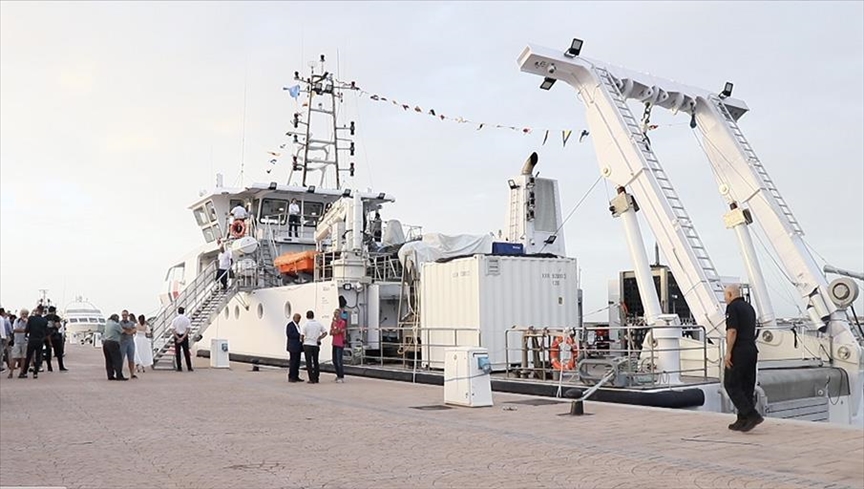
A successful underwater archaeological mission between Tunisia and Sicily
A.A. / Bizerte / Hind Abdel-Samad
On board the French archaeological excavation ship “Alfred Merlin”, the first international expedition to explore the wreck of the Banc des Esquerquis between Tunisia and Sicily, was launched on August 27 and ended on September 2.
The underwater exploration expedition to the Banc des Esquerquis located off the northern Tunisian coast and northwest of the Sicily Channel in the Mediterranean, part of a strategy aimed at strengthening cooperation between member states adhering to the 2001 UNESCO Convention for the Protection of Maritime Heritage, successfully.
The geophysical prospecting mission was carried out under the auspices of the Tunisian Ministry of Cultural Affairs in cooperation with the Agency for Heritage Development and Cultural Promotion, the National Heritage Institute and the United Nations Educational, Scientific and Cultural Organization (UNESCO),
Alfred Merlin had left the port of Marseille in France for the site of Esquerquis (Skerki), 90 kilometers off the coast of northern Tunisia.
On the ship’s bridge, the navigation commander, Captain Tibold Testud, in a statement to Anadolu Agency, spoke about the latest geophysical detection equipment and robotics for exploration and research in great depth.
“The vessel, which is 46 meters long, 10.80 meters wide and has a draft of 3.2 meters, has two underwater robots on board and can accommodate up to 28 people among archaeologists, robotics and shippers.” , select Tybold Testud.
“We make our own robots that meet the standards set for underwater exploration,” Dennis Digges revealed before noting that “the weight of the robots has to be relatively light so that we can transport them to rugged archaeological sites.”
“This robot weighs 80 kilos” defined the world of robotics.
“The robots are powered by the current provided by the boat, so they can operate underwater for up to 24 hours a day,” Diggs added.
In the “Robots Room”, a control room equipped with all kinds of screens, the roboticist simulated an ROV (underwater vehicle) operation at Anadolu Agency, identifying each displayed image, but also the robotic control panel. “Here we can control the height of the robot, its depth, as well as the power consumed by the motors,” he explained.
“This popular acoustic camera, placed in the ROV, allows us to see the targets we are going towards from a distance,” the robotics engineer noted.
“The robot is permanently positioned in real time on the map displayed on this screen, which is reproduced on the bridge, which allows the captain to see how the boat is positioned, and it is a real collaborative work between the crew and the robot scientists,” said Dennis Diggs.
In a statement to Anadolu Agency, the Tunisian Minister of Cultural Affairs, Hayat Catt Grammazi, highlighted the importance of international cooperation for her country, but also for the preservation of the common archaeological heritage and rare marine species. “This is a pioneering event for Tunisia, which is one of the first countries to accede to the 2001 UNESCO convention and which in 2013 hosted the first conference on antiquities and cultural heritage of the Arab world,” she said.
“The underwater archaeological heritage that dates back centuries to the seabed is a real wealth, as during this exploration mission three wrecks were found, including one of a ship dating back to the first century BC,” the Tunisian minister said.
In the same opinion, the Director of the Agency for the Promotion of Heritage and Cultural Promotion, Amal Hashanah, pointed out that “heritage is the property of humanity, and all countries must cooperate in order to protect and promote it, which first begins with scientific research.”
Tunisia hosted, in June 2021, the 8th UNESCO Conference on the Protection of the Underwater Cultural Heritage.
The partner countries that joined the 2001 UNESCO Convention are Spain, Italy, Algeria, France, Croatia, Egypt, Morocco and Tunisia.
Only part of the dispatches, which Anadolu Agency broadcasts to its subscribers via the Internal Broadcasting System (HAS), is broadcast on the AA website, in an abbreviated manner. Please contact us to subscribe.

“Organizer. Social media geek. General communicator. Bacon scholar. Proud pop culture trailblazer.”
